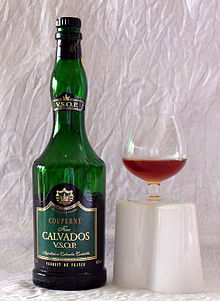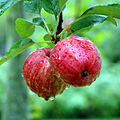Calvados (drink)
Calvados is an amber-colored apple brandy from Normandy . The name of the drink is derived from its protected designation of origin, the Département Calvados . Calvados are only allowed to call themselves the cider or poiré brandies (pear must), which come from a region of eleven precisely defined growing areas in Normandy. The alcohol content is 40 to 45 percent by volume (vol .-%).
history
The oldest written evidence for the production of an apple brandy in Normandy is a royal concession for Sire Gilles de Gouberville from Le Mesnil-au-Val from 1553 to distill an Eau de Vie de Sydre . The name Calvados came up later. Production was significantly expanded when, in the course of the French Revolution, every farmer who grew his own distilled fruit was granted the right to produce duty-free schnapps up to a volume of around ten liters of pure alcohol. This measure led to a considerable increase in the apple tree population in Normandy.
The first mention of the term Calvados for apple brandy after the department of the same name comes from the year 1884 and falls at the time when this drink made in Normandy was becoming increasingly popular in the capital Paris. Soon it became a synonym for all kinds of apple schnapps from this region. Until the Second World War , Calvados was still predominantly considered an inexpensive farmer's schnapps. There was no export worth mentioning. However, the German occupation of the country led to a radical change: for economic reasons, the German authorities ordered the confiscation of all French spirits stocks and ongoing production. The only exceptions were cognac and armagnac , whose distillates were subject to a precisely defined geographical designation of origin. The military administration set up a Bureau International professionnel de Cognac and a comparable office for Armagnac to control the harvests and their processing . The then French Minister of Agriculture Jacques Le Roy Ladurie , who himself came from Normandy, ensured that this practice was also transferred to the Calvados. In 1942, the Bureau National Interprofessionel des Calvados et Eau-de-Vie-de-Cidre (BNICE) was set up, which at the same time created the prerequisites for improving the quality and marketing the product. By establishing the limits of origin and product quality, Calvados received name protection, which was monitored by the office.
The damage caused by the landing of the Allies initially interrupted development. In addition, a significant part of the apple tree population disappeared in the post-war period due to the logging bonuses introduced by the government of Pierre Mendès France . The right to own distillery was curtailed by a new legal regulation in 1956, distilling rights could no longer be inherited by the farm heirs. In contrast, the production of industrial distilleries expanded further during this period, which was also a consequence of the general structural change in the rural regions of France in the post-war decades, where rural and artisanal businesses increasingly disappeared in favor of industrial ones. In October 1987, storm damage caused more losses than the Second World War, with the destruction of around 25 percent of the tree population.
In Germany, the calvados only spread to a greater extent after the Second World War. In 1987, German imports reached 2.2 million bottles in around 60 different brands from around 30 industrial distilleries. By the end of the 1980s, the Federal Republic of Germany became the main customer ahead of Switzerland, Japan and Belgium.
Distillation and storage
For the production of Calvados of fresh apple is most fermented into cider, which has an alcohol content of about 5 vol .-% in a few weeks. Only 48 different apple varieties are permitted. As a rule, 40% sweet apples, 40% bitter apples, and 20% sour apples should be mixed. Before distillation , this cider stays in the barrel for one to two years longer than the one intended for drinking.
This is followed by the two-stage distillation process : the first brandy (raw brandy) has an alcohol content of around 25% by volume and is also called petite eau (small water). This is now stored for some time and then burned a second time (fine brandy). The alcohol content of the water-clear fine brandy is now around 70% by volume. The spirit is then stored in barrels, preferably made of oak and chestnut , for two to six years before it is diluted to drinking strength and bottled.
The older the calvados, the more velvety and aromatic its taste. The color is then amber to cognac brown. The age designations are: VO or vieille réserve (four years), VSOP (more than five years) and Napoléon or XO (Extra Old, more than six years).
Apples in the Calvados region
Mobile Calvados still in Saint-Jean-des-Champs , Department Manche
Vieux Calvados ("old Calvados")
Production area and classification
There are three different varieties, the Calvados , the Calvados Pays d'Auge and the Calvados Domfrontais , the production areas of which are bindingly established by the Institut national de l'origine et de la qualité (INAO). The entire production process of these apple brandies - the apple harvest, processing and distillation - must be carried out entirely in the respective production area.
Accordingly, there are three different protective seals ( Appellation d'Origine Contrôlée , AOC) to describe the three production areas and the local production traditions. For example, at least 30% pears must be used to make Calvados Domfrontais .
Apple brandies that cannot be called Calvados are called Eau-de-vie de Pomme , Apple Brandy or Applejack and Aquardiente di Sidre .
Another classification takes place according to age. So there are the predicates:
- Fine - at least two years old
- VSOP - at least four years old (sometimes you read five years)
- XO - at least six years old
- Hors d'age - equivalent to XO, at least six years old
Drinking culture
In France, a calvados is traditionally drunk between two courses of a longer menu to "clear the stomach". This is known as “[faire] le trou normand ” (literally: “[to make] the Norman hole”).
In the past, calvados were usually drunk from simple shot glasses as a rural drink. With the rise of the noble spirit, thin-walled swivels with a tapering opening like for the cognac appeared. Calvados are also often served in drinking vessels made of clay or earthenware , which with their shape (3/4 of a ball) are supposed to remind of the skulls of the enemies from which the Normans drank.
Lambig
The Breton equivalent of Calvados is Lambig , also known as eau-de-vie de cidre de Bretagne . It only differs in the protected designations of origin. Ingredients and manufacturing processes are identical.
literature
- André Dominé : French specialties. Könemann, Cologne 1998, ISBN 3-8290-1649-2 , p. 116.
- Holger Hofmann: Calvados en vogue . Mosaik, Munich 1989, ISBN 3-570-03077-6 .
Web links
- Apples, cider and calvados in the Pays d'Auge, Normandy
- Ferme du Ponctey - Calvados Language depending on browser settings
Individual evidence
- ↑ For example, the Papidoux VSOP has the note: “after more than 5 years of oak barrel storage” on the back label.
- ↑ Lambig - Calvados from Brittany
- ^ François de Beaulieu: "Les cidres et leurs eaux-de-vie", éditions Ouest-France, 2000





